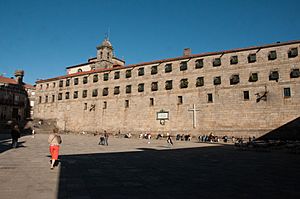Monastery of Saint Pelagius of Antealtares facts for kids
Quick facts for kids Monastery of Saint Pelagius of Antealtares |
|
|---|---|

Facade of San Paio de Antealtares in Quintana Square
|
|
| Religion | |
| Affiliation | Roman Catholic |
| Ecclesiastical or organizational status | Monastery |
| Location | |
| Location | Santiago de Compostela, Galicia, Spain |
| Architecture | |
| Architectural style | Baroque, Neoclassical |
The Monastery of Saint Pelagius of Antealtares (in Galician, Mosteiro de San Paio de Antealtares) is an old and important building. You can find it in Santiago de Compostela, a city in Galicia, Spain. It is a special kind of religious building known as a Monastery.
Contents
A Look at the Monastery's History
How the Monastery Began
This monastery was first built a very long time ago, in the 11th century. Alfonso II of Asturias, a king from that time, started it. It was first home to twelve Benedictine monks. Their main job was to take care of the newly found tomb of Apostle James. This tomb made Santiago de Compostela a very important place for pilgrims. People from all over would travel there to visit the tomb.
A New Purpose and Name
In 1499, the Benedictine monks left the monastery. After they left, a group of cloistered nuns moved in. These nuns dedicated the monastery to a young saint named Pelagius of Córdoba.
Pelagius was a boy from Galicia who lived in the 10th century. He was captured and asked to give up his Christian faith. When he refused, he became a martyr. This means he died for his beliefs. The nuns honored his story by naming the monastery after him.
The Buildings Today
Most of the buildings you see at the monastery today are not from the 11th century. They were built much later, mostly in the 17th and 18th centuries. This means the monastery has a mix of old history and newer architecture.
See also
 In Spanish: Monasterio de San Pelayo de Antealtares para niños
In Spanish: Monasterio de San Pelayo de Antealtares para niños
- Plaza de la Quintana
- Casa da Parra

